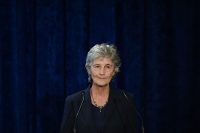Sometimes I have to admit the reason I read children’s books with pleasure is that I’m essentially puerile —and look, that’s not a bad thing if it means getting to read The Steves by Morag Hood (Pan Macmillan, £6.99), aimed at three year olds. It’s about two puffins called Steve who keenly resent the claims of the other to be Number One Steve. It is the kind of infantile playground name-calling which makes me laugh, and I reckon young children will like it too, especially Steves.
Judith Kerr, the peerless, razor-sharp author of The Tiger Who Came to Tea as well as the tear-jerker My Henry has, alas, gone to her reward in heaven, but we still, thank God, have Shirley Hughes, whose picture books for small children are as engaging as ever. You have to share a child’s-eye view, looking from below, to draw like she does, and maybe as you get older, that gets easier. All Around Me: A First Book of Childhood (Walker, £12.99) brings together some of her earlier books for tinies, introducing counting and shapes and noises.
For older children, Angel on the Roof (Walker, £12.99) is a lovely Christmas book, about a lame, lonely boy called Lewis Brown who lives in 32 Paradise Street in Notting Hill, London. One day he sees a golden feather floating by his window and strikes up a friendship with the angel on the roof who dropped it.
It’s odd how some distinguished authors just don’t hack it when it comes to younger children’s books. Noel Streatfeild, of Ballet Shoes fame, is deservedly well known for her books for older children, but here are two written for relative tinies. The Theatre Cat and Osbert (Scholastic, £9.99 each) are charming in their way, for the Theatre Cat redeems himself as a rubbish mouser by becoming an ace ballet coach and Osbert the poodle scrubs up nicely for a wedding, but they’re not much good as stories. They are, however, redeemed by terrific, lively illustrations by Susan Suba and generally lovely presentation.
Mary Shelley remains a figure of endless fascination 201 years after the publication of Frankenstein. For literary minded children, Linda Bailey’s Mary and Frankenstein (Andersen, £7.99) is a simple, engaging account of how the book came to be written, without getting too caught up in the author’s tangled home life. The creepy, evocative illustrations by Julia Sarda are just right.
Barbara Newhall Follett was ten when she wrote The House Without Windows, and it was published when she was 12. It created a sensation in 1927, and no wonder: her style is astonishingly lyrical. It’s about a little girl who runs away from home and lives without apparent need of shelter, food (other than roots and berries) or clothes (she dances in the snow), like a little sprite, tempting other children to play, until finally, she ‘rose into the air, and, hovering an instant over a great laurel bush, vanished’. It’s now republished in an edition introduced and illustrated by Jackie Morris (Hamish Hamilton, £12.99). Adults will find it wonderful; my 12-year-old found the interminable nature descriptions intolerable.
Tonke Dragt’s The Letter for the King is a wonderful book, about a young squire sent on a mysterious journey with a strange message and it captivated readers when it was translated from the Dutch; now we have The Goldsmith and the Master Thief from the same author (Pushkin, £12.99) first published in 1961 and translated by Laura Watkinson. In general, I bar identical twins or coincidental family resemblances as a plot device, apart from The Prisoner of Zenda, but these stories, engagingly illustrated by the author, about twins so identical they enter each other’s adventures, are charming.
Dyslexic children and struggling readers normally get short shrift, but the publisher Barrington Stoke commissions the best mainstream children’s authors, including Alexander McCall Smith and Gill Lewis, to write specifically for this group, so you get a pleasurable book with well-spaced layout and relatively simple sentence structure. Mal Peet’s Good Boy (Barrington Stoke, £7.99) is a short, creepy story about a girl haunted by a menacing hound which returns when she’s grown up. Terrific.
All right, this isn’t a reading book, but for games enthusiasts, Board Games to Create and Play (Pavilion, £22) by Kevan David and Viviane Schwarz may get them thinking. The earlier part, with assorted designs, is a bit offputting, but the bit giving creators various options about rules and rewards is more interesting. Actual obsessives of all ages will welcome Ian Livingstone’s Board Games in 100 Moves (DK £14.99), on everything from senet in Ancient Eygpt to Warhammer.
The most anticipated book of the year for mature young people was Philip Pullman’s The Secret Commonwealth (David Fickling books). I fell on it with relief because well-written stories with actual adventures are rare these days in teenage fiction. And our author doesn’t stint on the exotic: the hero and heroine travel in breathless succession from Oxford to middle-Europe to Constantinople towards exotic wastes where magical roses bloom, with the Magisterium (the Church) in hot pursuit.
It’s enjoyable of course; but you can’t help feeling that the author’s modus operandi — of not knowing what’s going to happen to his characters when he starts writing — has its drawbacks as the narrative tiringly jumps all over the place. Pullman’s trademark anti-God, anti-clerical agenda is modified here: there’s a priest who isn’t actually crazed, which is nice.
If you want a story that’s fantastical and compelling, try Sally Gardner’s Invisible in a Bright Light (Zephyr £10.99), about a girl in a nameless city, C—, in 1870. She is terribly maimed when a great chandelier in the opera house, shaped like a galleon, falls and shatters; it’s the same vessel that appears in her dreams, when she plays a game with a man in an emerald suit to rescue everyone on board. I’m afraid identical twins feature as a plot device here too, but it works.






Comments